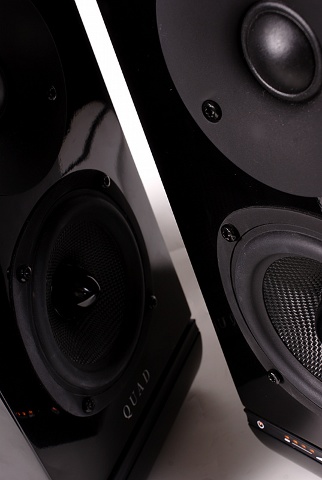about Audio, High Fidelity
& Home Entertainment technologies
pid: 607-2025/10/01 (v1.2)
Privacy Policy

With internal volume which is slightly less than 4.5 liters (4.3 to be exact), a measured response that goes down just below 60Hz and a 100 mm mid/woofer it is clear that 9AS is designed for small systems, covering a small/medium listening area. Quad suggests a distance between the loudspeakers of about 2-3m and the user cannot expect low frequencies capable to make the walls rattle. With this in mind, the 9AS pair to be reviewed was accompanied by a Quad subwoofer (L-ite) to evaluate the system in a 2.1 configuration. L-ite is an active sub with a 250 mm Tri-Lam driver, supported by a 300Wrms amplifier and an adjustable 35-85Hz low-pass filter. It was an impressive loudspeaker in terms of cabin finish, featuring a remote control that allows the real-time change of the cutoff frequency, so as to facilitate adjustment of the system. The evaluation process included four different phases in which the speaker used with and without the subwoofer in conventional (free field) and near field placement. In all cases the USB port was used as the input.
Given its small size, the 9AS will not create any set-up difficulties. It will work correctly placed even on a crowded shelf, as the relevant equalization option limits the output at low frequencies and the placement of the bass reflex at the rear seems not to be a problem. During the listening test, it was obvious that the loudspeaker can easily be used in a medium sized room, where the listening position is a little bit over 2.5 meters, as 9AS seems to have enough power and drive capacity to offer some serious levels before any compression occurs. With the addition of the sub, the result was quite impressive (given the size and the total price of the system, which with L-ite included is just over €1.500, -). Without the sub and at near free-field listening conditions, the 9AS shows some limitations towards the description of very low frequency content and it is possible that the listener loses some information, particularly in symphonic/electronic music recordings. Choosing the "boost" equalizer option, certainly somewhat fills the area, but the best solution for medium/large rooms is to accompany the 9AS with a good subwoofer (a solution which has brought some dramatic improvement, as you will read on next paragraph…).
Where the 9AS unfolds its virtues however, is at close-distance listening. In such usage profile, the first thing one evaluates as particularly positive is the potential of the loudspeaker to create a convincing, detailed and deep soundstage. 9AS disappears quite easily and the listener faces a window through witch the details of the recording and mixing processes are maintained even if the setup has a limited width. Good imaging properties are combined with a sense of balance in the mid and high frequencies, that makes listening very comfortable and pleasant, even at relatively high levels. The loudspeaker gives the impression that there are no details hidden, while its character is gentle enough to listen to it for long periods of time.
For the low frequency part of the spectrum, the rhythmic parts were sufficiently described and 9AS did not appear empty or harsh; instead it creates a feeling of good timing and clarity. However, some limits still exist, especially with symphonic orchestras and somewhat excessive electronic music, which is expected given the size of the loudspeaker. At this point, of course, the L-ite proved to be quite helpful. With cutoff frequency set to 85Hz and the 9AS equalizer set to "flat”, the results were impressive. The system improved significantly in its potential to describe low frequency details and to offer some serious levels without coloration.
Midrange performance is one of the strengths of 9AS. There is a sense of transparency, air and comfort without stressing anything. Highs feel extended with good harmonics, sufficiently bright, with very good temporal characteristics.
Overall, (with the L-ite included) the general impression one gets while listening to big orchestras and generally to rather complex music works is that the loudspeaker has good headroom and it is more that enough capable to describe the dynamic contrast of each recording. Close-distance listening helps to achieve quite high SPL levels before any kind of audible compression appears.
Conclusion
It turns out that 9AS is much more than a small loudspeaker designed with emphasis towards the new media or just a typical monitor that includes everything needed for desktop audio applications. It is a well designed, well engineered but still quite affordable product that is able to convince even the most reluctant of us to cope with the idea of a small active system being really good in audiophile terms. Combined with the L-ite subwoofer, 9AS are setting a reference level for high quality 2.1 systems in this price range.



